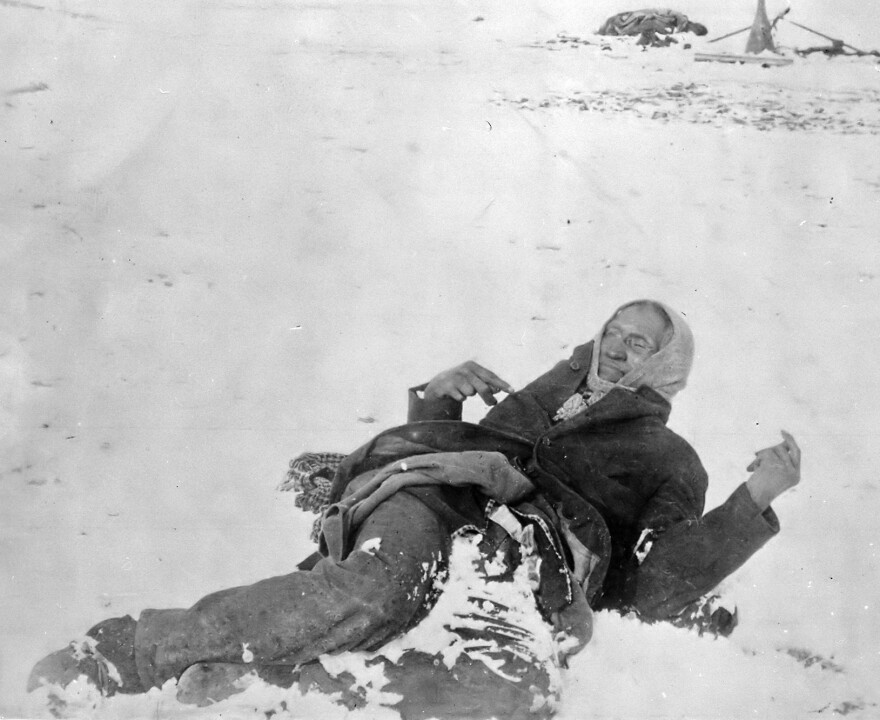Coventry, an English city of 250,00 in the West Midlands, was home to significant industrial power when World War II began, a line of industries Hitler wouldn’t and didn’t miss. When the Battle of Britain began, a specific Coventry blitz started immediately and didn’t end for three long months--198 tons of bombs killed 176 people and injured almost 700.
But the worst was to come. On November 14, 1940, 515 Nazi bombers unloaded on Coventry’s industrial region, leaving the city in ruins. Its own air defenses fired 67 hundred rounds, but brought down only one bomber. It was a rout.
At 8:00 that night, St. Michael’s Cathedral, a fourteenth-century church, was hit and burned, destroyed like so much else as a city turned to ruin.
In the skeletal hulk of that Cathedral, the BBC recorded an ancient hymn that had originated in Coventry in the 16th century, part of a series of morality plays, the only such hymn to survive. The BBC’s Christmas program that night was broadcast from the heart of Britain’s “darkest hour,” and because it was, people remembered that ancient hymn because they could not forget it.
Today, that hymn is called “The Coventry Carol,” and it’s unlikely that any of you who are listening to these words would find it unfamiliar.
The story of that ancient hymn is told in its setting, a Christmas story whose shuddering reality is easier not to remember. The old story goes that after the birth of Jesus, King Herod, determined to hold on to his own kingdom, ordered the immediate execution of every living male child under three years old. It is impossible to imagine the anguish that flowed down the region’s streets.
In those old morality plays, “The Coventry Carol” was sung by three Bethlehem women holding babies who were bound to die. Together, they create a haunting melody of multiple vocal lines. If you’ve not brought the Coventry Carol together with its own history, you’ll never hear it again without knowing the horror of its setting.
The event traditionally called “The Massacre of the Innocents,” is probably best not remembered on the night before Christmas. It’s just so dark. It may well be a blessing that most of us blindly sing “The Coventry Carol” right along with “Little Town of Bethlehem” and “Santa Claus is Coming to Town.”

Oddly enough, the “massacre of the innocents” shares the calendar with another massacre, this one just down the road, a day’s travel west, just 127 years ago, a massacre that took place in a huge open near a creek whose odd name should never be forgotten, Wounded Knee.
In late December of 1890, what white men determined to be hostility on the South Dakota reservations, the Ghost Dance, brought the largest Calvary assembled anywhere since the Civil War a quarter century before.
It was late December cold. Big Foot, a Mineconjou chief from the Cheyenne River Reservation, known as a peacemaker, was on his way to the Red Cloud Agency, when accosted by troops from the Seventh Cavalry, the company that had taken a beating with Custer at Little Bighorn. On a cold morning in an action that lasted for two agonizing hours, 300 men, women, and children, the Lakota say, were massacred, the last fight of what historians call “The Great Sioux Wars.”
To my ears at least, the haunting harmonies of “The Coventry Carol” seem to emerge from the frozen prairies all around us on December 30, as do the words, actually. In vocal style, the carol’s spectral choral line—“lully, lulay, lully, lulay” has absolutely nothing in common with the strains of a chorus of Lakota Death Songs that must have arisen that day on the plains.
Don’t be fooled. Despair speaks a universal language. The words of those Bethlehem women, “lully, lulay,” originate in an old English expression that long ago fell out of usage. Some linguists say that chorus—“lully, lulay, lully, lulay”—repeat the agonizing testimony of those Bethlehem mothers: “I saw, I saw; I saw, I saw.” But who among the survivors would not have chanted something similar?
The Massacre of the Innocents may be folklore; some would argue so.
Even though Wounded Knee is not, the determined lament of the old language holds just the same, on the killing fields out west. “Lulay, lully.” I saw. I saw.
None of us may have been there, but all of us were.
---
Support for Small Wonders on Siouxland Public Media comes from the Daniels Osborn Law Firm in the Ho Chunk Centre in downtown Sioux City, serving needs of clients in real estate transactions; business formation and guidance; and personal estate planning. More information is available on Facebook or at danielsosborn.com.








